Of the media that most influenced my childhood and early teenagehood, at the very top sits W.I.T.C.H., the Italian fantasy magical girl comic book created by Elisabetta Gnone, Alessandro Barbucci and Barbara Canepa. It is the story of five magical girls with elemental powers, that are asked by the Oracle of Kandrakar to protect all the worlds in their realm - including Earth. Their names (Will, Irma, Taranee, Cornelia, Hay Lin) spell out their group name - W.I.T.C.H.
Published in Italy under the Disney umbrella as monthly magazines between 2001 and 2012, it ran for 139 issues. During this time, it also ran in multiple other countries as translations - an article from Variety in 2004 said it was published in 27 languages.
In Romania, issue #1 came out in May 2003, published by Egmont. My ten-year-old self saw it at a newsagent’s, among all the other newspapers and glossy magazines, and instantly gravitated towards it. I bought it for 27.000 ROL (after the 2005 monetary re-evaluation, this would now be 2.7 RON) - in GBP, that’s around 50p. I had enough pocket money to afford it - and so a life-long love began.
But it was hard - again, this was 2003 and I had the limitations of a ten-year-old - so I didn’t always manage to buy every monthly issue. Some months I would forget (December was notoriously bad because of the Christmas holidays), and most summers I would spend at my grandma’s, who didn’t believe in wasting money on magazines - so, yeah. And if I didn’t manage to get the issue of that month, that was it - I couldn’t buy it anymore. From the 139 total issues, I only managed to buy 56 - a measly 40%. And yet, they were enough, because I read and re-read them over and over again.
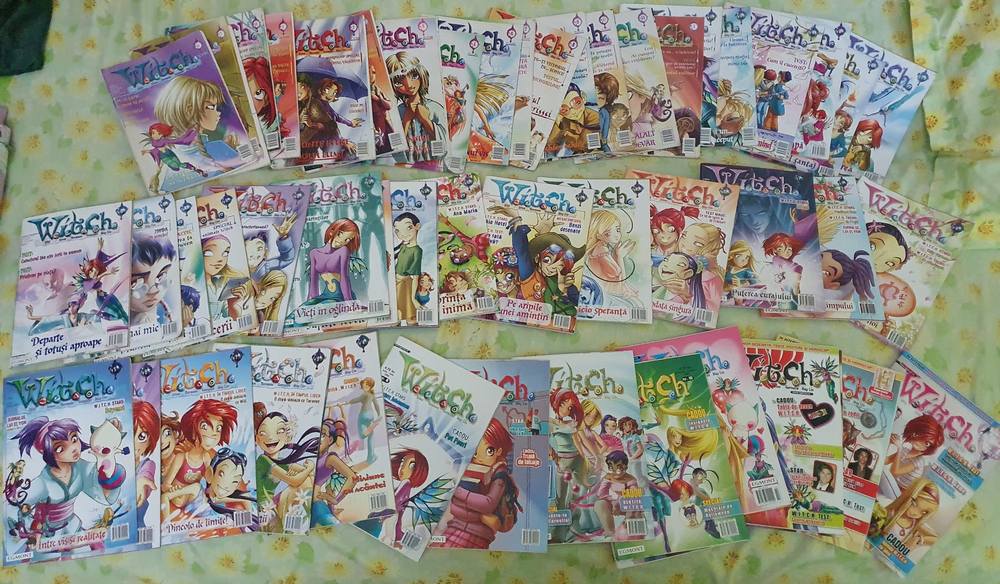
Most of my 56-issue collection
From my own collection of issues, I only managed to get:
- 2003 - 8 issues (it came out in May, so I have the full 2003 run)
- 2004 - 12 issues (full)
- 2005 - 11 issues (missed December)
- 2006 - 8 issues
- 2007 - 7 issues
- 2008 - 6 issues
- 2009 - 4 issues
Going back to the publication years, Romania started publishing it two years after Italy - and assuming the same monthly schedule was kept without interruption, they would have finished releasing the entire series in 2014.
So I have the first 31 issues uninterrupted, then it starts getting more scattered. The last issue I ever got was just as the Ragorlang plot arc was ending, issue #74. I bought these comics when I was aged 10 to 17 - I literally grew up with these characters. In fact, one comic panel I come back to time and time again, as I thought about these comics, was Irma in issue #1, where she says 'Oof! It’s hard to be a 13-year-old!'. I first read that as a ten-year-old - and as the years passed, I eventually turned 13, and was exactly the age Irma was - sadly, I kept growing and growing, and have now considerably grew past that age. And yet, I remember - damn, Irma was right. It was hard being a 13-year-old.
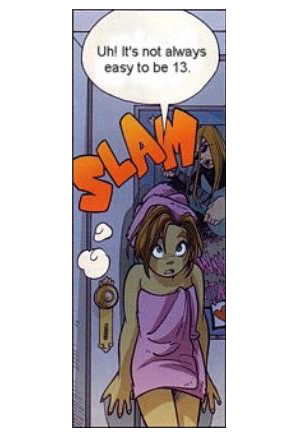
Irma decrying her preteen struggles
Eventually, I would be able to read the rest of the issues I missed, due to the incredible fan efforts online to provide scanlations (shout-out to witch-a-holic.tk) - again, this was when once you couldn’t buy an issue, it was gone from you forever - plus, I think the comics were more popular in non-English speaking countries, so getting an English translation was quite hard. You can find fannish activity in forums like on TapaTalk. Quite noble was that once the comics started getting reprinted by Yen Press, earlier scanlations were taken down to encourage fans to support by buying the reprints. What’s left of the scanlations are in this thread.
The comics are made up of 11 arcs, with a variety of specials, mini-comics and extra material on the side. My favourites are the first two arcs - The Twelve Portals and Nerissa’s Revenge. I’ve since bought the first three volumes of the Yen Press reprints, re-read my entire collection of saved scanlations, all 139 issues - twice! - and revisited my collection of magazines, that are currently stored in my childhood home. And going through these old issues (2003 was actually quite a while ago, despite the lies you try to tell yourself), it inspired me to try to write more about this incredible fan experience.
These magazines weren’t just the W.I.T.C.H. comics themselves - there were so much more, content that is not included in the scanlations or reprints, and I suspect they’re very much unique to each language they were translated in. These were very much children’s (girls') magazines, so any filler content was meant to appeal to them.
For example, issue #6 of the Romanian version includes a character sheet for Elyon, a monthly horoscope, three different quizzes (‘What type of friend are you?’, ‘What kind of W.I.T.C.H. fan are you?’ and ‘What should you dress up as for Halloween?’), how to DIY your own dreamcatcher (… it was 2003 and Romania was not aware of cultural appropriation), a ‘magical autumn’ spread covering celtic, witchy and druid stuff (but like, for kids). Other issues included characters’s bedrooms or diary entries from a shared diary. The extra content that was witch-themed was a lot of fun (things like tea leaf reading, magic crystals, dream journalling).
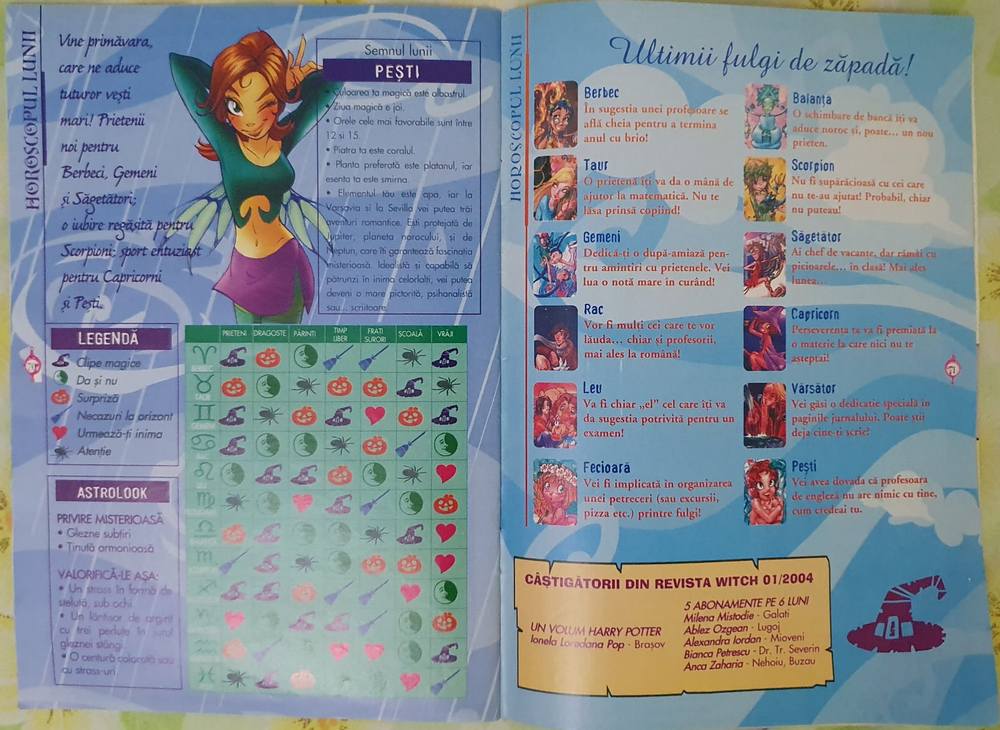
One of the many horoscopes from the magazine
On the last page (and this is such a blast from the past) was a form you could fill in to subscribe for 6 or 12 months to this magazine, and other similar magazines (Mickey Mouse, Barbie, Tom & Jerry, Princess [which was about Disney princesses] or National Geographic Junior). You had to ask a parent for help to mail it to a P.O. box.
Another blast from the past (that is very early 2000s) is that with the advent of cellphones (not smartphones, these were cellular devices) a big trend among the youth was personalising them - and how you could do that, was choosing your favourite ringtone or screensaver, and buying it from catalogues like these, usually printed at the back of magazines! W.I.T.C.H. also had these in at least a couple of issues.

A plethora of ringtones and screensavers!
There were also various contests! If you answered a question about something that happened in issue (‘What did Cornelia find underneath her bed?’) and sent it in, you could potentially win various prizes, like a subscription, other W.I.T.C.H. print media books (which I’ll cover in another article, dolls, inline skates, candy etc. Sometimes there would be cross-promotion with other releases (like in 2004, the newly-released Order of the Phoenix book).
By far, the coolest thing was the fanletter space. You would get fans from all over the country writing in, asking the editor questions, or wanting to connect with other fans - and they would share their home address, email, Yahoo!Messenger ID or phone number (it was a different time! Eventually the editor did put in a notice that they wouldn’t publish their home addresses until explicitly requested). The letters were very sweet and innnocent - fans pleading with the editors to increase the number of pages, to launch a forum, to publish more quizzes, to add posters in the middle of the magazine, even to add more gifts (a very cheeky fan brazenly said the German and Hungarian versions gave hair accessories and stickers, so why couldn’t you?). Eventually some issues would also include small gifts, and that issue would normally be in a plastic bag/wrap to keep it safe: hair accessories, small jewellery, badges, shoelaces, stickers.
The editor would also answer Agony Aunt-style questions, advising fans about their issues with their friends, parents - and the terrifying ‘boys’. Fans also sent it poetry, photos, homemade cosplay - one fan even got excerpts from the novel she was writing published!
This space was called The Letter Cauldron, then changed to The Witches’ Club - then eventually renamed as The Witches’ and Wizards’ Club (it wasn’t cool for boys to admit even they read girls’ comics - but there were a few boys writing in to declare their love for the comics).
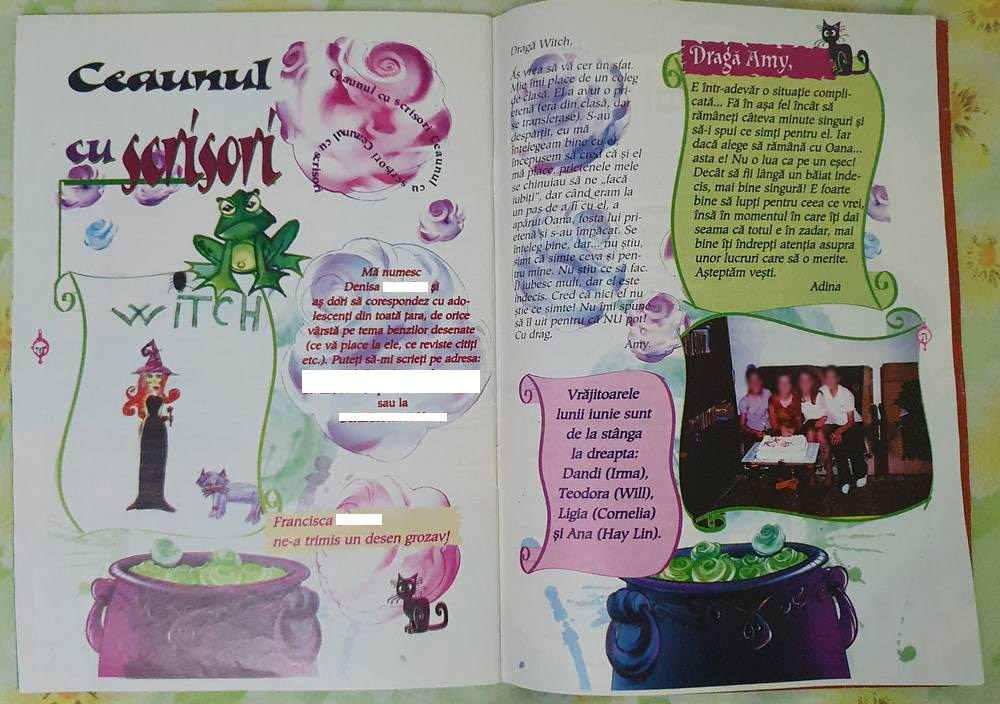
The Letter Cauldron from a 2004 issue (surnames, home addresses, emails blanked, and minors' faces blurred)
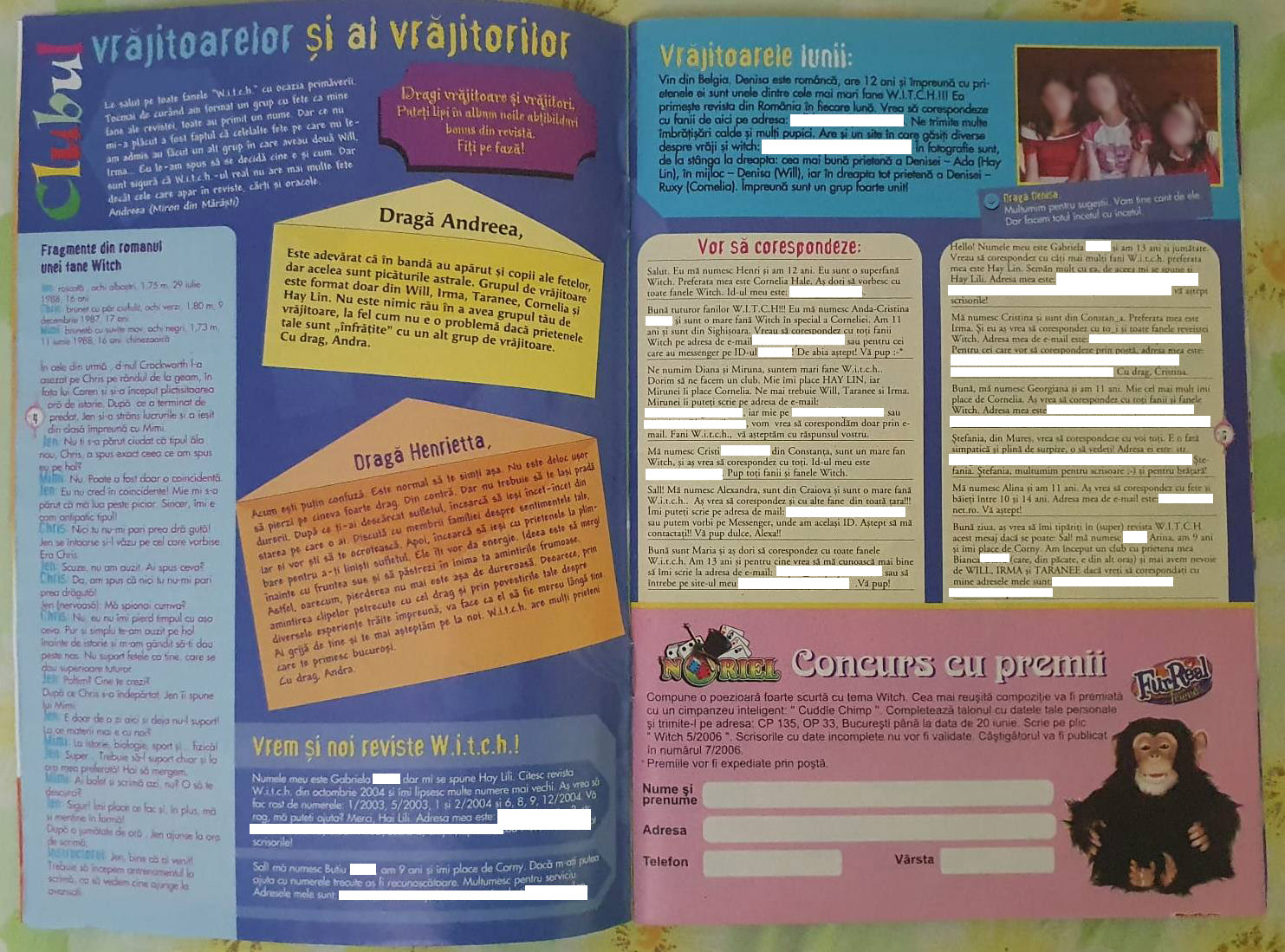
The Witches’ and Wizards’ Club from a 2006 issue (surnames, home addresses, emails blanked, and minors' faces blurred)
Many fans were starting W.I.T.C.H. fanclubs, and would assign each member a character, and send photos of themselves to be published (‘I’m Emma and I’m the Cornelia of the group, and my best friend Anne is the Irma of the group’ etc.) - which so resembles the fannish behaviour I did in that age bracket (10-15) in the early-mid 2000s. (I was always the Irma of the group - and in the Harry Potter fanclub I formed at school, I was the Hermione of the group).
It seems I wasn’t the only one grieving the inability to purchase old issues, as eventually the editor published a phone number to call and order missing issues (and at some point, they had to announce older copies could no longer be purchased) and there was even a section of fans asking other fans for missing issues, to trade duplicates etc.
Later on (around 2005-2006) more people were creating their own blogs and websites about W.I.T.C.H, and asked other fans to visit them. Sadly these do not longer exist, but just shows the immense fan dedication in creating space for fannish activity.
And fandoms did overlap - many fans professed their love for other magic-related fandoms, like Harry Potter, Winx Club and Charmed. In one 2005 issue, the editor joyfully announced the midnight release of The Half-Blooded Prince at a mall in Bucharest that November. Eventually, the content moved from tween to teen (as the audience also grew up with the characters), and pages about celebrities and bands started being included (of particular note, is the overlapping mania of Tokio Hotel and RBD that took hold in Romania).
The editor also said a few words in ths editorial (it would be called the witchitorial). The first Romanian editor of the magazine was Adina Antonie, then from april 2005 Andra Botescu, then from may 2007, Florian Vladâcenco (and the fact that it was a boy editor made quite a bit of commotion in the fandom, with the previous editor encouraging the readers to ask him all their boy-related questions). In his very first intro, he said 'W.I.T.C.H. belongs to you in its entirety'.
From around 2004, the commercialisation of W.I.T.C.H. began. I could write a whole article just on the merch pushed (to be fair, it’s still Disney - and Disney’s gonna Disney). There was an entire series of stories, novels, and practical guides. There were dolls, a sticker album (which I sadly never got!), a A to W(itch) dictionary (in the style of A to Z books), a school agenda, a diary and so many others knick-knacks.
The W.I.T.C.H. animated series, started running in Romania from October 2005, on the kids’ channel Jetix. It is… not wholly accurate to the comics. When a fan wrote in and asked the editor why the characters were so different from the comics, the editor dryly replied - 'because it’s made by the French'.
As I was skimming through the issues I had, spanning 2003 to 2009, I noticed a certain tonal change. I think the most exciting times were the early years, 2003-2006. Later on, it got a whiff of corporate meddling - fewer letters were being published, and instead they crammed more ads in. The first issue I have has 78 pages - while the last one has 68 pages.
Also, as the issues progressed, there were certain plot elements, inconsistencies and retcons that bothered me. Arc 8, which concerned itself with starting a magic school for magical children that were hiding all throughout their town, felt incredibly lackluster. And from around this time, issue #97 and up no longer had multiple-issues arcs, but each issues had its own self-contained, individual story. The magic was no longer there.
Remember when I said that Romania would have finished published all issues in 2013, if all went well? Well, this forum post from May 2010 from a Romanian fan says that it’s been confirmed that they stopped publishing after arc 7, and the last number will be #86.
And that’s disappointing, as they blame low sales, but considering I visually saw a decrease in the quality of the magazine, I’m not surprised. And it seemed other countries also started cancelling their issues before getting to the final #139.
For my part, I collected the issues, and bought the adventure books, novels and practical guides, which I want to write their own articles about - merely because information about them is very sparse online, particularly in English-speaking spaces, but I think they have their own value and are worth talking about.
I am grateful I finally got to read the end of the series, and it wouldn’t have happened without the fans that put in so much work into archiving and making it available online, to people who wouldn’t have had the opportunity to do otherwise. And the fans are still here! And just like any fandom that had its heyday moment, back in the day, they still live online, in their own fannish spaces.
Article originally posted on 22 September 2024.